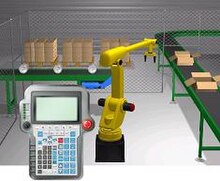This article possibly contains original research. (August 2014) |
A robotics simulator is a simulator used to create an application for a physical robot without depending on the physical machine, thus saving cost and time. In some case, such applications can be transferred onto a physical robot (or rebuilt) without modification.
The term robotics simulator can refer to several different robotics simulation applications. For example, in mobile robotics applications, behavior-based robotics simulators allow users to create simple worlds of rigid objects and light sources and to program robots to interact with these worlds. Behavior-based simulation allows for actions that are more biotic in nature when compared to simulators that are more binary, or computational. Also, behavior-based simulators may learn from mistakes and can demonstrate the anthropomorphic quality of tenacity.

One of the most popular applications for robotics simulators is for 3D modeling and rendering of a robot and its environment. This type of robotics software has a simulator that is a virtual robot, which can emulate the motion of a physical robot in a real work envelope. Some robotics simulators use a physics engine for more realistic motion generation of the robot. The use of a robotics simulator to develop a robotics control program is highly recommended regardless of whether a physical robot is available or not. The simulator allows for robotics programs to be conveniently written and debugged off-line with the final version of the program tested on a physical robot. This applies mainly to industrial robotic applications, since the success of off-line programming depends on how similar the physical environment of a robot is to a simulated environment.
Sensor-based robot actions are much more difficult to simulate and/or to program off-line, since the robot motion depends on instantaneous sensor readings in the real world.